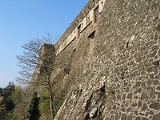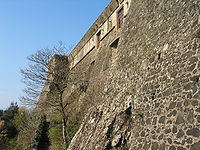
Aulla
Encyclopedia
History

Roman Empire
The Roman Empire was the post-Republican period of the ancient Roman civilization, characterised by an autocratic form of government and large territorial holdings in Europe and around the Mediterranean....
and Etruscan civilization
Etruscan civilization
Etruscan civilization is the modern English name given to a civilization of ancient Italy in the area corresponding roughly to Tuscany. The ancient Romans called its creators the Tusci or Etrusci...
s found in the Church of Saint Caprisio indicate that there were settlements in Aulla long before the 8th century CE, when margrave Adalbert I of Tuscany
Adalbert I of Tuscany
Adalbert I was the margrave of Tuscany from about 847.He was the son of Margrave Boniface II, who had been despoiled of his fiefs by the Emperor Lothair I, and successor of his elder brother Aganus...
founded a village and castle to accommodate pilgrims traveling the via Francigena
Via Francigena
The Via Francigena is an ancient road between Rome and Canterbury, passing through England, France, Switzerland and Italy. In mediaeval times it was an important road and pilgrimage route...
. Here, at Aguilla Sigeric, Archbishop of Canterbury
Sigeric the Serious
Sigeric was the Archbishop of Canterbury from 990 to 994.It is unclear whether the epithet "The Serious" originated from his learning, or if it derived from transliteration of his name into Latin as Serio.- Biography :...
, sojourned on his return journey from Rome
Rome
Rome is the capital of Italy and the country's largest and most populated city and comune, with over 2.7 million residents in . The city is located in the central-western portion of the Italian Peninsula, on the Tiber River within the Lazio region of Italy.Rome's history spans two and a half...
about 990. The Malaspina family wrested feudal power of the city and its contada from the domination of the bishops and dukes of Luni. In 1543 the Centurione family purchased it. They built the Fortress Brunella, which was bought in the early 20th century by Lina Watterfield, and remains privately owned, functioning as a museum of natural history for the Lunigiana
Lunigiana
The Lunigiana is an historical territory of Italy, which today falls within the provinces of La Spezia and Massa Carrara. Its borders derive from the ancient Roman settlement, later the medieval diocese of Luni, which no longer exists....
region.
One of the most important buildings of the town is the Abbey of S. Caprasio that was founded in the 8th Century and was named by Saint Caprasius of Lérin, whose body was transferred to Aulla in the 10th century.
In 1943 the historic center of Aulla was destroyed by Anglo-American bombings aimed at German troops stationed there during the Second World War
World War II
World War II, or the Second World War , was a global conflict lasting from 1939 to 1945, involving most of the world's nations—including all of the great powers—eventually forming two opposing military alliances: the Allies and the Axis...
. A copy of one unexploded bomb is preserved in the Abbey of S. Caprasio.

